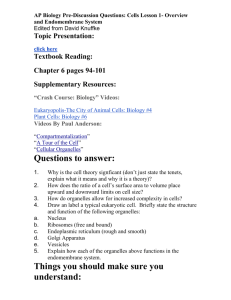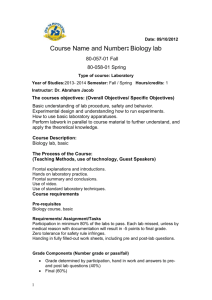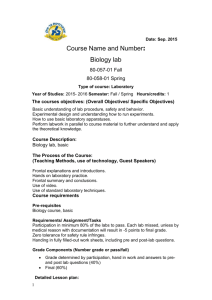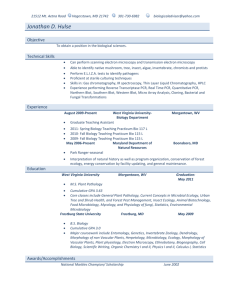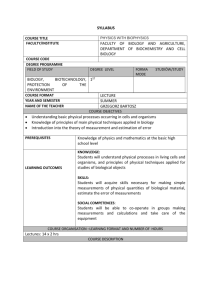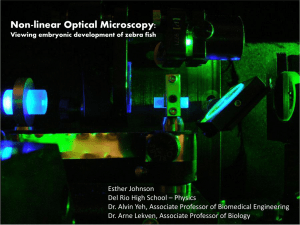Microscopy: History, Usage, and Utility
advertisement
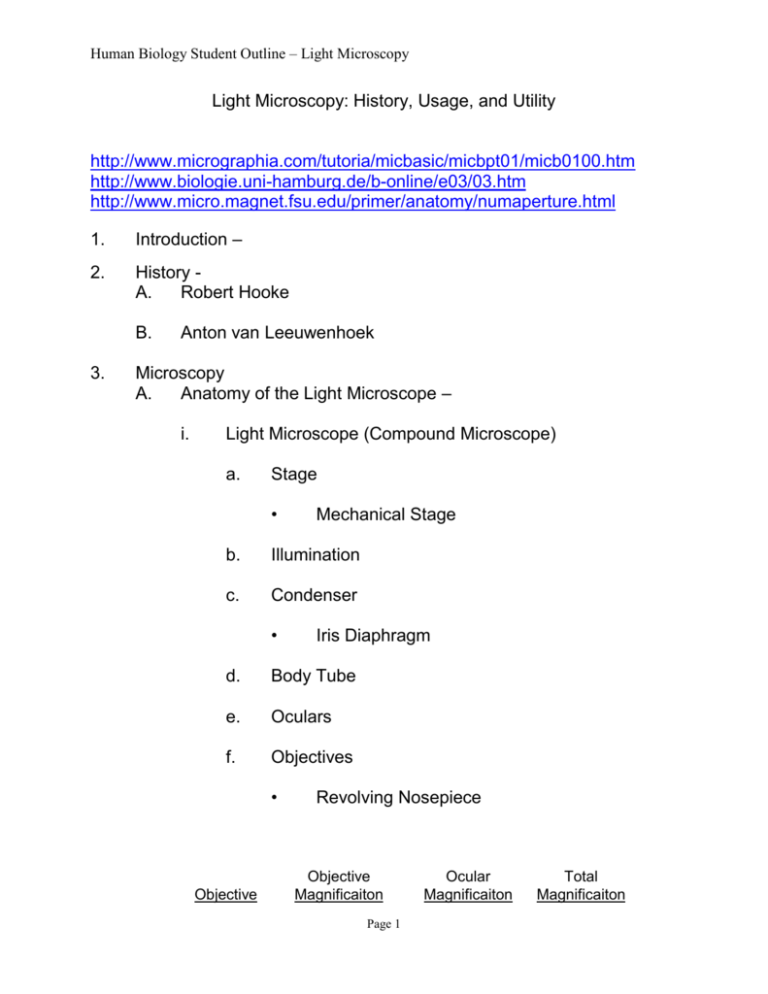
Human Biology Student Outline – Light Microscopy Light Microscopy: History, Usage, and Utility http://www.micrographia.com/tutoria/micbasic/micbpt01/micb0100.htm http://www.biologie.uni-hamburg.de/b-online/e03/03.htm http://www.micro.magnet.fsu.edu/primer/anatomy/numaperture.html 1. Introduction – 2. History A. Robert Hooke B. 3. Anton van Leeuwenhoek Microscopy A. Anatomy of the Light Microscope – i. Light Microscope (Compound Microscope) a. Stage • Mechanical Stage b. Illumination c. Condenser • Iris Diaphragm d. Body Tube e. Oculars f. Objectives • Objective Revolving Nosepiece Objective Magnificaiton Page 1 Ocular Magnificaiton Total Magnificaiton Human Biology Student Outline – Light Microscopy Scanning Low Power High Power Oil Immersion g. 4x 10 x 45x 97x Focus • Coarse Adjustment • Fine Adjustment * B. 10x 10x 10x 10x Parfocalization The Nature of Light i. Speed Page 2 40x 100x 450x 970x Human Biology Student Outline – Light Microscopy ii. Refraction Indices of Refraction Vacuum 1.000 Air 1.000277 Water 1.333 Flint Glass 1.57 – 1.75 n = index of refraction; C = speed of light in vacuum; V = speed of light in a particular material http://hyperphysics.phyastr.gsu.edu/hbase/geoopt/refr.html#c1?n1=3&n2=4&th1=23&th2=34 Page 3 Human Biology Student Outline – Light Microscopy C. Fundamentals of Optics i. Focal Point ii. Anti-point iii. Image Page 4 Human Biology Student Outline – Light Microscopy b. • Resolving Power (RP) Angular Aperture Page 5 Human Biology Student Outline – Light Microscopy • “Airy Disks” http://www.micro.magnet.fsu.edu/primer/anatomy/numapertu re.html Page 6 Human Biology Student Outline – Light Microscopy u = 1/2 angular aperture N.A. = sin u Therefore the NA range will be roughly 0 to 1 sin 0 = 0 sin 90 = 1 Effect of sin on angle Magnification NA Relative Page 7 Human Biology Student Outline – Light Microscopy 1x 10x 40x 100x (oil) (Plan Achromat) Resolution 0.025 0.25 0.65 1.25 Poorest Best N.A. = n sine u Snell’s Law seen above Refractive Index of Air = 1 Refractive Index of Oil = 1.515 Refractive Index of Water = 1.33 Refractive Index of Glycerin = 1.47 Refractive Index of Glass = 1. 515 N.A. = n sine u Page 8 Human Biology Student Outline – Light Microscopy Resolution or Resolving Power = wavelength of light RP = 2 x NA Page 9 Human Biology Student Outline – Light Microscopy Example: For white light using a 10x objective White Light (average wavelength = ~550 nm) RP = 550nm = 550 = 1100 nm or 1.1 m 2 x 0.25 0.50 Blue Light RP = 450nm = 450 2 x 0.25 0.50 = 900 nm or 0.9 m Red Light RP = 650nm = 650 2 x 0.25 0.50 = 1300 nm or 1.3 m Resolution using a lens with fixed numerical aperture of 0.95 at varying wavelengths Wavelenght () of Light (nm) Color 360 Deep Violet 400 Violet 450 Blue 500 Blue-Green 550 Green-Yellow 600 Orange 650 Red 700 Deep Red Resolution (µm) 0.19 0.21 0.24 0.26 0.29 0.32 0.34 0.37 Resolution can also be increased by the following: Page 10 Human Biology Student Outline – Light Microscopy 1. 2. 3. 4. Blue filter, will allow only the shorter wavelengths of blue to hit the organism Condenser, kept at its highest position for maximum amount of light to enter Diaphragm should not be stopped, but opened Immersion Oil, only when the 100x is used. Example (100x oil immersion): (understand that the resolving power has been increased due to a higher refractive index) With white light RP = 550nm = 550 2 x 1.25 2.50 = 220 nm or 0.22 m Slide in a blue filter and turn up the light intensity RP = 450nm = 450 2 x 1.25 2.50 = 180 nm or 0.18 m Page 11
